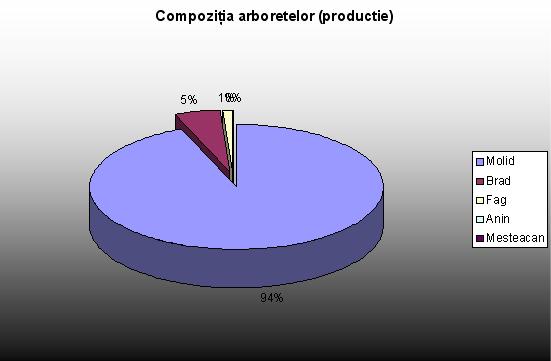CHARACTERISTICS OF THE FOREST FUND 1. Forest Formations and Types
Unmixed Norway Spruce Stands (FM3) - these stands have a relatively simple structure being almost exlusively formed by Norway Spruce, scarcely associated with quickbeam, common silver birch, sycamore, mountain elm, silver fir or common beech. Shrubs and bushes are missing but one can sometimes find samples of fly honeysuckle, elm leaved spiraea, red currant bush. The grass layer is usually poorly developed with few superior plants as Oxalis acetosella, Soldanella hungarica, Hieracium transilvanicum, Vaccinium myrtillus, Vaccinium vitis-idaea. In most of the Norway Spruce stands moss can be found, forming a more or less continuous layer. This moss is made up of Hylocomium, Rhytidiadelphus, Dicranum. The biomass production ranges from 3-6 t/ha/year, depending on the trophicity of the soil and the climatic requirements of the biotopes. 2-5 t/year/ha stands for the wood concentration of this biomass production.
Mixed Stand of Norway Spruce-Silver Fir-Common Beech - together with the silver fir stand they form a distinct band in the area. The edificating species is the beech, which associates itself in great diversity, either with the silver fir or the Norway spruce, or with both of these species. Shrubs and bushes can hardly be found here, only hazelnut, elder, scarlet elder, fly honeysuckle are slightly present. The grass layer is formed by some species of mull flora like Salvia glutinosa, Cardamine glanduligera, Pulmonaria rubra, Allium ursinum, Rubus hirtus, Festuca altissima, Luzula luzuloides, Vaccinium a.s.o. Forest biomass production is approximately 9t/ha/year.
As far as the natural distribution of forest trees is concerned the highest rate of occurence is shown by the Norway spruce stand together with the Oxalis acetosella (41%), this being the most productive forest type, followed by the Norway spruce with green moss (17%) and the Norway spruce associated with fir and mull flora (10%).
The table of the forest types is given below:
| Nr.crt. |
Site type |
Forest type |
Percentage |
| Code |
Name of species |
% |
| 1 |
2.3.3.1 |
111.5 |
Norway spruce with Oxalis acetostella on skeletal soils pe soluri schelete de prductivitate inferioar |
1 |
| 2 |
2.3.3.2. |
111.3 |
High dimension Norway spruce with Oxalis acetosella |
6 |
| 111.4 |
Norway spruce with Oxalis acetosella on skeletal soil |
3 |
| 112.1 |
Norway spruce with green moss |
17 |
| 3 |
2.3.3.3 |
111.1 |
Common Norway spruce with Oxalis acetosella |
41 |
| 4 |
2.6.3.0 |
117.1 |
Norway spruce with grey alder |
- |
| 973.1 |
Common alder on swamped soils of mountain region |
- |
| 5 |
3.3.3.2 |
111.4 |
Norway spruce with Oxalis acetosella on skeletal soil |
1 |
| 6 |
3.3.3.3 |
111.1 |
Common Norway spruce with Oxalis acetosella |
21 |
| 121.1 |
Norway spruce associated with fir and mull flora |
10 |
| Total |
100 |
2. Forest Composition
As a storey of trees the forest stand is a prevailing biosystemic characteristic of the forest and it constitutes the main object of forest management.
Although the structure of the stand and of the forest in general shows shared characteristics, moreover both component parts and concentration in space is being referred to here, in practice when assessing the stand both horizontal and vertical structural characteristics are taken into consideration together with their own peculiarities. In this sense the horizontal characteristics refer to the composition and crown density of the stand while on the other hand the vertical characteristics involve its storeyed structure, profile and closing.
Beside these quantitative characteristics the stand has qualitative characteristics as well like: the origin, source, age, site class and fitosanitary condition.
The wooded area is grouped into two production subunits:
- distinct conservation system (protection forests) - 371 ha
- high-forest system (protection-production) - 23.056 ha
The site composition in the high forest system is the following: 94% Norway spruce, 5% fir and silver birch, 1% common beech and alder.

The site composition in the protection forests gives 71% Norway spruce, 21% alder, 6% sliver birch, 1% larch and 1% maple.

The rate of species on the sites administrated by the Forest Administration of Gheorgheni is the following:
| Area covered |
SPECIES |
TOTAL |
| NS |
F |
LA |
BE |
AN |
SB |
MA |
| ha |
21839 |
1171 |
234 |
93 |
24 |
37 |
29 |
23427 |
| % |
94 |
5 |
1 |
0 |
0 |
0 |
0 |
100 |
According to the table above the Norway spruce is the most prevailing of the species covering 94% of the district area, followed by the fig with 5% and finally the larch with 1%.
3. Age class structure
The age class structure is presented in the following table:
| Area covered |
Age class |
TOTAL |
| I |
II - IV |
V |
VI |
VII |
|
| 1-20 |
21 - 80 |
81-100 |
101-120 |
>120 |
| Ha |
2110 |
15227 |
3045 |
2811 |
234 |
23427 |
| % |
9 |
65 |
13 |
12 |
1 |
100 |

We can observe that the age class stucture is predominated by classes II, III, IV that represent trees aged between 20 and 80 having a 65% rate; on the other hand classes I, V, VI are quite balanced and represent a rate of 9%, 13% and 12%.
4. 4. Site class structure
The distribution of site class is presented in the diagramme below:

According to the diagramme the area under the administration of Forest Administration of Gheorgheni is formed by high production stands covering 15.769 hectares (67%), the medium production stands cover 7.262 hectares (31%) and the lower production class is represented on a surface of 396 hectares, which makes up only 2% of the whole area
5. Stand quality and vegetation
In accordance with the stipulations in force, the forest hygienic and cleaning operations in the forests are organized and carried out in such a way as to ensure permanent and adequate fito-sanitary condition.
The forest hygienic and cleaning operations are directed to the following types of timber:
- trees torn, failed, crashed by the wind or snow, dry, attacked by insects, trap trees that need urgent removal
- dry wood and thick branches lying/spread all over the forest
- the unreclaimed remains on felling area where cleaning was carried out
- the thin timber resulting from tending operations
- uprooted tree stumps due to natural phenomenon
The timber that would negatively influence the fitosanitary conditions of the forest must be arranged and removed.







